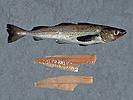|
|
 |
 |
Pollock (Theregra
Chalcogramma)
Click on the images to enlarge |
Common names: Alaska pollock, Walleye pollock, pollock.
Regional names: Bigeye cod, snow cod, whiting, Pacific tomcod, Pacific pollock.
Identification: Three well separated dorsal fins. Anus below
space between first and second dorsal fins. Small or no barbel on lower jaw.
Lower jaw slightly projecting. Color is olive green to brown on dorsal surface,
silvery on side and dusky to black on fins.
Range: Central California Coast through the Bering Sea.
Western Pacific from Kamchatka to southern Sea of Japan.
Season and Catch Methods: January-February, June-July and
September-October in the Gulf of Alaska. January-February and September-October
in the Bering Sea. Caught primarily by trawl with incidental catches by
longline and pot.
Size: Range 1 to 4 lbs, average 1½ to 2 lbs.
Product forms: Fresh: Skinless-boneless fillets. Frozen:
dressed/headed; skinless-boneless fillets in block, IQF or shatterpack; mince
in blocks and surimi. Fillets typically graded to: 2-4 oz, 4-6 oz, 6-8 oz and
8-12 oz.
Packaging: Fresh: fillets in 10 and 15 lb poly bags; 10, 12 or
20 lb plastic boxes. Frozen: dressed/headed fish 50 to 80 lb boxes, fillets in
10, 15 and 25 lb shatter packs and IQF, fillets and mince 16½ lb blocks, surimi
22 lb blocks.
Nutritional Value (3.5 oz (100 g) raw, edible portion): 81
Kcal, 7.2 Kcal from Fat, 17 g Protein, 1 g Total Fat, 0.2 g Saturated Fat, 0.2
g Omega-3 Fat, 71 mg Cholesterol, 99 mg Sodium.
|
|



